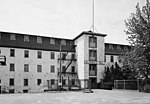Clemence–Irons House
1691 establishments in Rhode IslandBuildings and structures in Johnston, Rhode IslandHistoric American Buildings Survey in Rhode IslandHistoric New EnglandHistoric house museums in Rhode Island ... and 5 more
History of New EnglandHouses completed in 1691Houses in Providence County, Rhode IslandHouses on the National Register of Historic Places in Rhode IslandMuseums in Providence County, Rhode Island

The Clemence–Irons House (also known as the Edward Manton House) is a historic house located in Johnston, Rhode Island. It was built by Richard Clemence in 1691 and is a rare surviving example of a "stone ender", a building type first developed in the western part of England and common in colonial Rhode Island. The house is listed on the National Register of Historic Places, and is a historic house museum owned and operated by Historic New England. It is open Saturdays between June and mid-October.
Excerpt from the Wikipedia article Clemence–Irons House (License: CC BY-SA 3.0, Authors, Images).Clemence–Irons House
Greenville Avenue,
Geographical coordinates (GPS) Address Nearby Places Show on map
Geographical coordinates (GPS)
| Latitude | Longitude |
|---|---|
| N 41.839166666667 ° | E -71.484444444444 ° |
Address
Greenville Avenue 269
02919
Rhode Island, United States
Open on Google Maps







